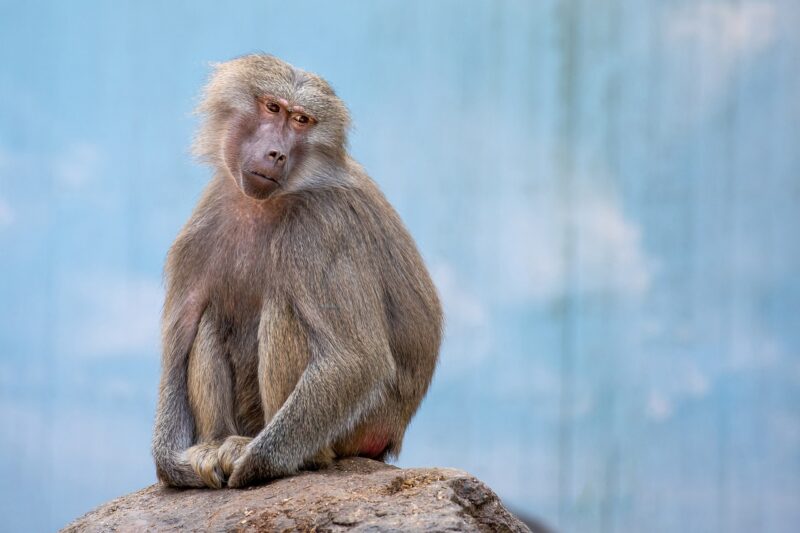How Monkeys and Apes Communicate: Body Language, Sounds, and Expressions
November 15, 2024

Communication among monkeys and apes is a fascinating subject that intertwines biology, evolution, and social behavior. As primates, both monkeys and apes share a significant amount of genetic material with humans and possess sophisticated means of conveying information, whether through vocalizations, body language, or facial expressions. Understanding these forms of communication enhances our knowledge of their social structures, survival tactics, and even offers reflections on our own communication.
1. The Importance of Communication in Primate Societies
Communication plays a crucial role in the social lives of monkeys and apes. It is essential for:
- Establishing Hierarchies: Many primate species, including baboons and macaques, have complex social structures. Communication helps establish and maintain social hierarchies through displays of dominance or submissiveness.
- Cooperative Behavior: Primate groups often rely on teamwork for hunting, foraging, and protecting their young from predators. Effective communication facilitates cooperation within these groups.
- Warning Signals: Vocalizations and body language are utilized to alert fellow group members to potential dangers, including predators or rival groups. These warning systems are vital for survival in the wild.
Understanding these functions can give us insights into the evolutionary development of communication, a trait shared with our human ancestry.
2. Vocal Communication: Sounds and Calls
Vocalizations are a prominent component of primate communication. Each species has its own unique sounds that can convey a range of messages:
- Types of Calls: Monkeys and apes use various calls, including screams, hoots, barks, and howls. For instance, the howler monkey produces one of the loudest calls in the animal kingdom, often used for territorial displays and group cohesion.
- Alarm Calls: Certain calls warn others of predators. Different alarm calls may indicate specific types of threats (e.g., aerial predators versus terrestrial ones), showcasing a level of sophistication in the warning systems.
- Mother-Infant Communication: The relationship between mothers and infants is particularly important, with specific vocalizations that signal comfort, distress, or the need for attention. These sounds enable infants to develop critical social skills and recognition of their mother’s voice.
By studying the nuances of these vocalizations, researchers can gain insights into the social dynamics and survival strategies of different primate species.
3. Body Language: Non-Verbal Communication
While vocalizations are significant, body language is equally essential in primate communication. It includes:
- Posture and Movement: The way a monkey or ape stands, sits, or moves can indicate its emotional state and intentions. For example, a relaxed posture may signal submission, while a rigid stance could indicate aggression or readiness to defend territory.
- Facial Expressions: Primates display emotions through facial expressions. Smiles, grimaces, and other facial movements convey feelings such as happiness, fear, or submission. The similarities in these expressions with human emotions provide essential clues about our shared evolutionary past.
- Grooming Behavior: Grooming is not just about hygiene; it is also a vital form of social bonding. Monkeys and apes often groom each other to reinforce social bonds and build alliances within their groups, showcasing a silent but powerful form of communication that emphasizes trust and friendship.
Body language in primates serves to augment their vocalizations, providing context and meaning that might not be captured through sound alone.
4. A Study of Specific Species: How Different Primate Groups Communicate
Different species demonstrate unique communication styles, influenced by their ecological and social environments. Here are a few examples:
- Chimpanzees: Known for their close genetic link to humans, chimpanzees utilize a rich combination of vocalizations, facial expressions, and gestures. They are known to use tools and often communicate their intentions during these activities, showcasing higher cognitive abilities.
- Gorillas: Like chimpanzees, gorillas use a mix of vocalizations and physical gestures. Lowland gorillas demonstrate strong maternal bonds, with mothers using specific calls and gestures to communicate with their young. Their expressions display a wide range of emotions, highlighting their complexity.
- Capuchin Monkeys: These small monkeys are known for their intelligence and sociality. They use a wide array of vocalizations and are remarkably adept at employing facial expressions and body movements to communicate effectively within their groups. Their communication often reflects their playful nature and social hierarchies.
Examining these species provides us with critical perspectives on the adaptation of primate communication styles.
5. The Evolution of Communication: From Primates to Humans
The study of how monkeys and apes communicate sheds light on the evolution of human communication. The parallels between primate communication systems and human language suggest:
- The Roots of Language: Many researchers believe that studying vocalizations and body language in primates presents clues about how human language may have evolved from simpler forms of communication.
- Cognitive Abilities: The complexity of communication in primates hints at advanced cognitive capabilities, shared selectively with humans. Understanding these connections can reshape our views on intelligence, social behavior, and the origin of language.
- Cross-Species Communication: Insights into how non-human primates communicate can inform our understanding of communication barriers and similarities among different species, including the potential for interspecies communication with humans.
The exploration of paralinguistic cues and communication through body language enriches our understanding of the evolutionary development of human communication.
Conclusion: The Rich Tapestry of Primate Communication
Monkeys and apes exhibit an extraordinary range of communication mechanisms that encompass vocalizations, body language, and facial expressions. Their sophisticated interactions provide critical insights into their social structures and evolutionary backgrounds.
As we continue to study these remarkable creatures, we not only learn more about them but also reflect on the very nature of communication that we, as humans, engage in daily. By unraveling the complexities of primate communication, we deepen our appreciation for biodiversity and its implications for understanding our own species.
Further Research and Appreciation
The study of primate communication is a continuously evolving field. Conservation efforts, habitat preservation, and ongoing research play crucial roles in safeguarding these species, allowing future generations to explore and learn from the captivating world of primate communication.







